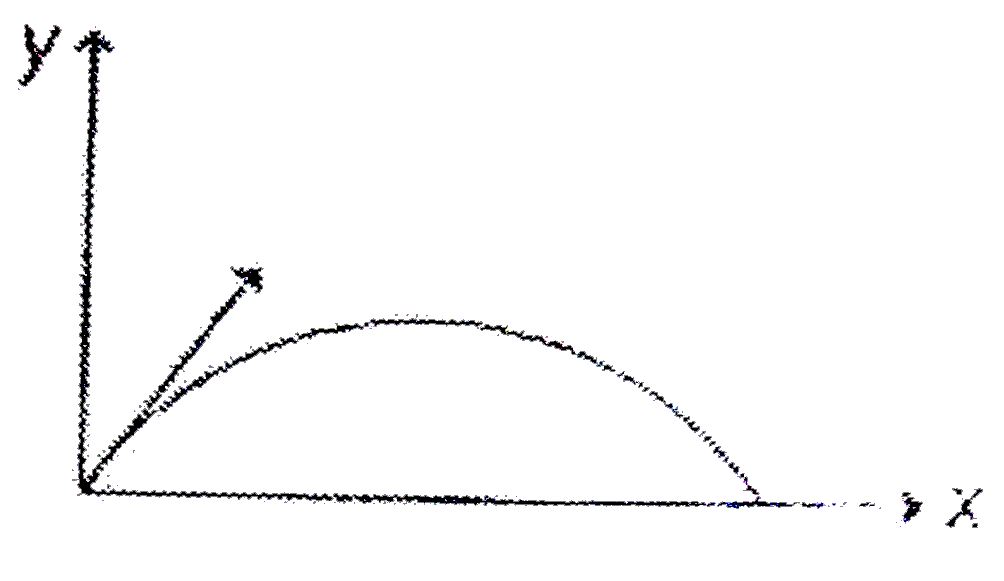When air resistance is taken into account while dealing with the motion of the projectile which of the following properties of the projectile, shows an increases?
range
maximum height
speed at which it strikes the ground
the angle with horizontal at which the projectile strikes the ground
The correct Answer is:D
To solve the problem, we need to analyze the effects of air resistance on the motion of a projectile. Here’s a step-by-step breakdown:
Step 1: Understand the Motion of a Projectile
A projectile is an object that is thrown into the air with an initial velocity. In the absence of air resistance, it follows a parabolic trajectory due to the influence of gravity.
Hint: Remember that the motion of a projectile can be analyzed in two dimensions: horizontal and vertical.
Step 2: Introduce Air Resistance
When air resistance is considered, it acts as a force opposing the motion of the projectile. This force affects both the vertical and horizontal components of the projectile's motion.
Hint: Air resistance (drag) acts in the opposite direction to the velocity of the projectile.
Step 3: Analyze the Effects of Air Resistance
1. Vertical Motion: While the projectile is moving upwards, air resistance acts downwards, reducing the upward velocity. When the projectile is descending, air resistance acts upwards, reducing the downward velocity.
2. Horizontal Motion: Air resistance acts in the opposite direction of the horizontal motion, reducing the horizontal distance traveled.
Hint: Consider how air resistance changes the acceleration of the projectile in both the upward and downward motions.
Step 4: Determine Changes in Projectile Properties
- Maximum Height: The presence of air resistance decreases the maximum height reached by the projectile because it reduces the upward velocity more than it would in a vacuum.
- Range: The range of the projectile is also reduced due to air resistance, as it decreases the horizontal distance traveled.
- Speed at Impact: The speed at which the projectile strikes the ground is reduced because air resistance acts against the motion during descent.
- Angle of Impact: The angle at which the projectile strikes the ground can increase due to the effect of air resistance. The projectile may not follow the same trajectory as it would in a vacuum, leading to a steeper angle of descent.
Hint: Focus on how air resistance alters the trajectory and the resulting angle of impact.
Step 5: Conclusion
From the analysis, we can conclude that the only property that shows an increase when air resistance is taken into account is the angle with the horizontal at which the projectile strikes the ground.
Final Answer: The angle with the horizontal at which the projectile strikes the ground increases.
A projectile is an object that is thrown into the air with an initial velocity. In the absence of air resistance, it follows a parabolic trajectory due to the influence of gravity.
When air resistance is considered, it acts as a force opposing the motion of the projectile. This force affects both the vertical and horizontal components of the projectile's motion.
1. Vertical Motion: While the projectile is moving upwards, air resistance acts downwards, reducing the upward velocity. When the projectile is descending, air resistance acts upwards, reducing the downward velocity.
2. Horizontal Motion: Air resistance acts in the opposite direction of the horizontal motion, reducing the horizontal distance traveled.
- Maximum Height: The presence of air resistance decreases the maximum height reached by the projectile because it reduces the upward velocity more than it would in a vacuum.
- Range: The range of the projectile is also reduced due to air resistance, as it decreases the horizontal distance traveled.
From the analysis, we can conclude that the only property that shows an increase when air resistance is taken into account is the angle with the horizontal at which the projectile strikes the ground.
Topper's Solved these Questions
- Motion in Two DimensionsBook:VMC MODULES ENGLISHChapter:Motion in Two DimensionsExercise:JEE Main (Archive)
Explore 19 Videos
- Motion in Two DimensionsBook:VMC MODULES ENGLISHChapter:Motion in Two DimensionsExercise:JEE Advanced (Archive)
Explore 19 Videos
- Motion in Two DimensionsBook:VMC MODULES ENGLISHChapter:Motion in Two DimensionsExercise:Long Answer Type
Explore 5 Videos
- Motion in Straight Line Book:VMC MODULES ENGLISHChapter:Motion in Straight Line Exercise:IN-CHAPTER EXERCISE-J
Explore 10 Videos
- MOVING CHARGES & MAGNETISM Book:VMC MODULES ENGLISHChapter:MOVING CHARGES & MAGNETISM Exercise:IN-CHAPTER EXERCISE-K
Explore 10 Videos
Similar Questions
Knowledge Check
Which of the following is true regarding projectile motion ?
AHorizontal velocity of projectile is constant.BVertical velocity of projectile is constant.CAcceleration is not constant.DMomentum is constant.Which of following property shows the property of ferromagnetic substances?
AThe ferromagnetic property depends, on temperature.BThe ferromagnetic property does not depend on temperature.CAt high enough temperature ferromagnet becomes a diamagnet.DAt low temperature ferromagnet becomes a paramagnet.Which of the following oxides shows electrical properties like metals?
ASiO2BMgOCSO2 (s)DCrO2
Which of the following projectiles is the best for bombarding the nuclide?
View SolutionIn halogen, which of the following properties increase from iodine to fluroine
View Solutionwhich of the following oxides shows electrical properties like metals ?
View SolutionWhich of the following property gradually increase from C to F ?
View SolutionWhich of the following oxides shows electrical properties like metals ?
View Solution


